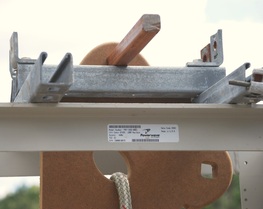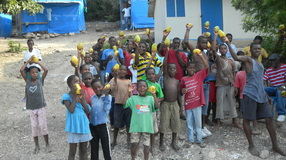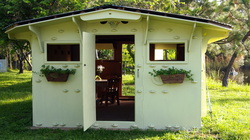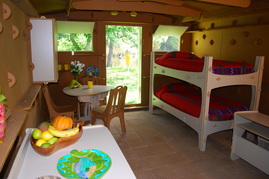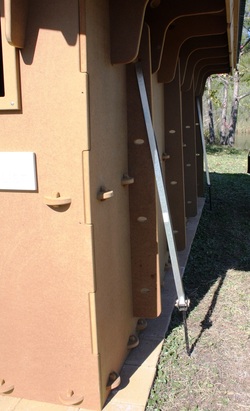
I never really understood how strong fiberboard was until we ran some basic tests to try to get an idea of the strength of our new Shelter. We use a new, easy to assemble mortise and tenon joint with a locking peg to build our Shelter. We took a single tenon loop (the ‘tab’ of our Tool Free Joint) and hung it in a steel fixture so that weight could be hung from it for testing. This loop has a thickness of one inch and the amount of material around the loop was one inch, resulting in a load bearing cross section of one square inch of fiberboard. Then we added weight to the loop using six of my largest friends sitting on a wood beam and at maximum capacity of the beam, we had over 1,300 pounds of live weight on one square inch of fiberboard, without distortion or failure. It is important to keep in mind that this loading represents the worst case scenario for loading of the joint, a straight pull. In practice, the joints of the Shelter will never have loads applied in a straight line, they will load at various angles where the joint is much, much stronger. There are a 350 or so of these joints in a Shelter. The tool Free Joint and the fiberboard materials are a new technology for building construction.
| There is one more feature of our Shelter worthy of note. Between all the wall and roof panels there are a series of ‘finger’ joints (see the picture). These joints absorb any ‘twist or shift’ between adjoining panels. If the panels do not shift relative to each other they do not load the connecting joints in a ‘scissors’ fashion. I know this is esoteric but it means that the overall structure works together to remain rigid, adding to the overall strength. Earth anchor tie-downs finish the building system. Taken together, the material, the joint, the finger joints between panels and the tie down system create s solid wood, very strong, long lasting house that will keep standing and protecting, when the going gets tough. |
About Shelter In A Day | Disaster Relief Housing

The Shelters are a solidly constructed, termite, rust and rot resistant house, with lockable doors and windows. Homes are crafted from waterproof, recycled wood fiber material and can be easily erected anywhere, in one day. Shelter In A Day is the brainchild of eco-friendly, furniture designer Frank Schooley. These emergency disaster relief shelters provide safe and secure, simple to construct, green housing for those displaced by natural disasters, such as hurricanes, earthquakes or floods.
The Shelters are a solidly constructed, termite, rust and rot resistant house, with lockable doors and windows. Homes are crafted from waterproof, recycled wood fiber material and can be easily erected anywhere, in one day.
Our test model disaster relief house (recent picture above) has withstood Florida's elements the last 20 months beautifully.
